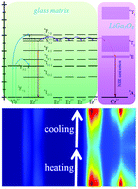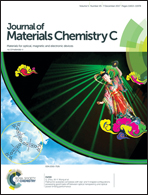Yb3+/Ln3+/Cr3+ (Ln = Er, Ho) doped transparent glass ceramics: crystallization, Ln3+ sensitized Cr3+ upconversion emission and multi-modal temperature sensing
Abstract
Currently, efficient photon anti-Stokes (upconversion) luminescence is mostly limited to lanthanide (Ln3+) doped materials. There are a few reports on upconversion behaviors of transition-metal ions, whose (Stokes) emissions are known to be tunable by changing the crystal fields of the hosts. Herein, Yb/Ln/Cr (Ln = Er, Ho) tri-doped glass ceramics were fabricated by a melt-quenching route and subsequent glass crystallization, where Cr3+ dopants were evidenced to be incorporated into the precipitated LiGa5O8 nanocrystals and Ln3+ ions remained in the glass matrix. An intense Cr3+ upconversion luminescence assigned to the 2E → 4A2 transition was observed upon 980 nm laser excitation via energy transfer from Yb3+ sensitizers to Er3+ activators/bridging-centers and finally to Cr3+ emitting centers. Importantly, the investigated glass ceramics presented temperature-dependent upconversion fluorescence intensity ratios for Er3+ 2H11/2/4S3/2 thermally coupled states as well as Cr3+/Ln3+ non-thermally coupled states and temperature-sensitive upconversion decays of Cr3+ 2E/4A2 thermally coupled states, enabling their promising applications in self-calibrated multi-modal temperature sensing.



 Please wait while we load your content...
Please wait while we load your content...